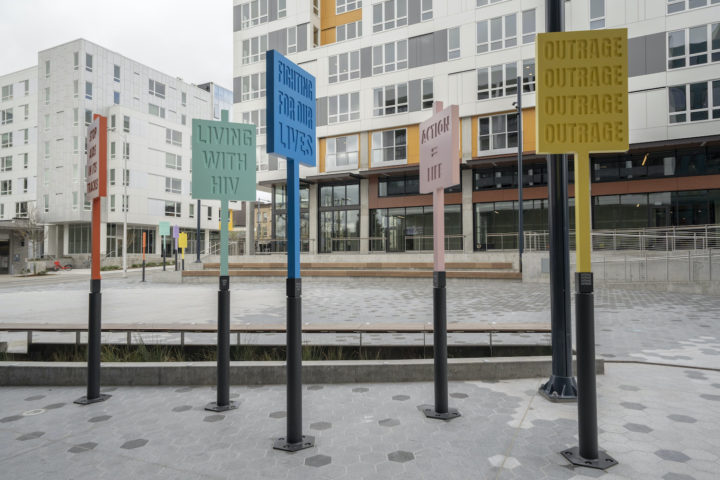We’re Already Here
LOCATION:
In the plaza and park (3 locations)
About the Artwork
We’re Already Here commemorates the collective action that defines Seattle’s dynamic response to the AIDS crisis. The work consists of three tableaus which use protest signs and their accompanying messages to evoke historic moments of public convergence. Within the timeline of the epidemic, there are countless examples of such moments. Protests, demonstrations, parades, vigils, and memorials are events where diverse communities came together in alliance against the shared exigency of AIDS and HIV. These civic spectacles were crucial in breaking through the silence, apathy, and ignorance that perpetuated the deaths of thousands during the first decade of the epidemic.
The specific artifacts referenced in We’re Already Here were sourced from actual demonstrations that took place throughout the region during the eighties and nineties. By positioning these signs as subjects of creative canonization, we are celebrating these public displays and immortalizing the messages that were employed within them.
Protest signs are, by their very nature, impermanent and disposable items; yet, their function is vital. Within the era of AIDS, these objects were the graphic battle cries of a community under siege—the visual expression of fear, rage, and grief turned into action. Rendering these ephemeral articles in permanent and durable materials both amplifies their meaning and expands their narrative. Cheap paper and flimsy wooden sticks, when translated into metal and concrete silhouettes, become looming and ceremonious figures. Bold and vibrant words, when re-envisioned as deeply inscribed typography, conjure the visual language of remembrance. The debossed depth of the latterforms cast shadows which evoke the facades of memorials or monuments.
The signs are finished in vibrant colors—each one in a different hue. A primary function of these artworks is to guide visitors through the AMP site. Their vivid coloration provides an element of wayfinding. The multicolored groupings will act as visual markers which connect the park and plaza areas.
The title of the work comes from an article that appeared in the Seattle Times in April of 1990. The article is about a public demonstration that took place in Madison Valley to garner support for an AIDS care center that would later become the Bailey-Boushay House. The leader of this demonstration was a man named Brian Day. Day was a well-known Seattle business owner and a celebrated activist who focused on issues concerning the LGBTQ community, AIDS and HIV and people of color. The image that accompanies the article is quite striking—it’s a picture of Brian Day standing in front of a crowd, speaking into a megaphone while pointing to the sky.
In the article, Brian was asked by the interviewer to respond to the fact that there were residents in the area who were opposed to the center being built—fearful of people with AIDS coming into their neighborhood.
Brian replied, “We’re already here…”
Brian Day’s seemingly simple reply is an urgent demand for legitimacy and action, and perfectly encapsulates the aims of the demonstration he was leading that day as well the objectives of the countless other public demonstrations that took place during the AIDS crisis. These moments of collective action were critical in generating awareness around the epidemic, inspiring understanding, and support within the greater public, and motivating government leaders and policy makers to provide resources for education, prevention, and treatment.
Acknowledgements
Fabrication and Installation: Davis Sign Company
Lighting Consultant: Luma Lighting
Landscape Design: Jonathan Morley, Berger Partnership
Landscaper: Green Tech Excavation
Special thanks: Michael Evans, The AMP CAG, Rebecca Johnson, Jason Plourde, Michele Hasson, Marlys Erickson, Tom Rasmussen, Kristen Ramirez, Kelly Goold, Maija McKnight, Mark Adreon, Anne McGettigan, Tim Burak, Ro Yoon, Rosette Royale, Fred Swanson, Dr. Bob Wood, Jeff Sakuma, Grace Kim, and Mira Mui.

Civilization
Civilization (est. 2007) is a design practice founded by Michael Ellsworth (b. 1979), Corey Gutch (b. 1974), and Gabriel Stromberg (b. 1976) in Seattle. Since the studio’s inception, it has built identity systems, digital experiences, printed materials, environmental graphics, and exhibitions that are engaging, empathetic, sustainable, and create meaningful connections.
The practice is a recipient of the prestigious National Design Award for Communication Design from the Cooper Hewitt, Smithsonian Design Museum in honor of “excellence, innovation, and enhancement on the quality of daily life.” Their internationally recognized work is included in the permanent collection of SFMOMA and the Milton Glaser Design Archives at SVA, has won numerous awards including a Webby Award for Best Activist Website, and is regularly featured in print publications as well as most major global media outlets such as The Guardian, The New York Times, The Huffington Post and NPR.
The founding members lead workshops and lecture globally. The collective intelligence of the team comes from dedication and experience in the fields of graphic design, technology and the arts with diverse organizations—from museums to global NGOs. Working with those committed to creating positive change, their clients include the National Head Start Association, The Nature Conservancy, Shout Your Abortion, Asia Society, and The Biennale of Sydney.






